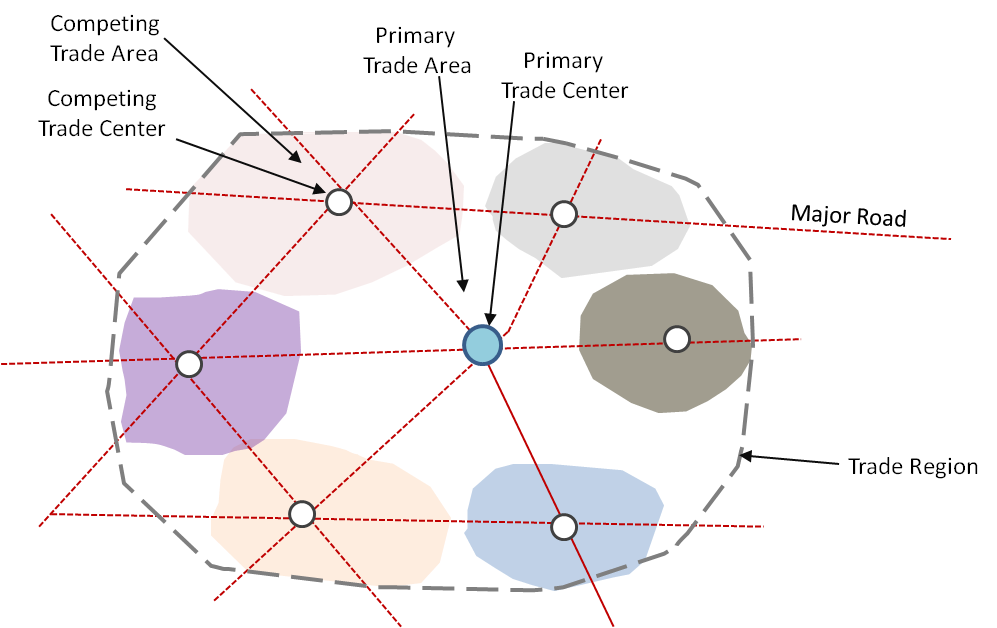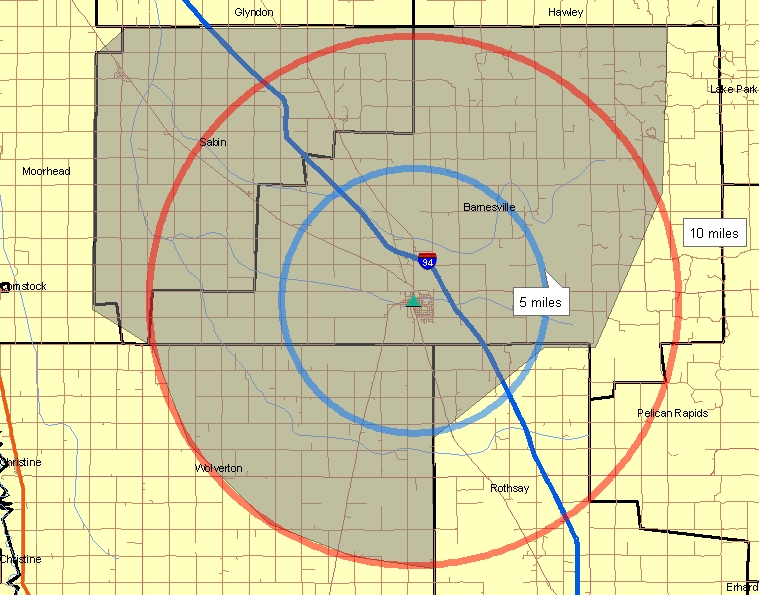Trade area analysis is a crucial process used by businesses, real estate professionals, and civic planners to evaluate the potential customer base and competitive landscape for a location. But what exactly does conducting a trade area analysis entail?
In this comprehensive guide, we will explain what trade area analysis is, why it matters, key methods and uses, and how leveraging location analytics can take your analysis to the next level
Defining Trade Area Analysis
Trade area analysis refers to the practice of studying and mapping the business activity, consumer behavior, and market dynamics surrounding a specific location.
The “trade area” is the geographic region from which consumers are willing to travel to shop or access services at a business. Trade area analysis aims to define the boundaries and opportunities within this area.
Key goals of trade area analysis include:
- Identifying who the potential customers are and where they come from
- Understanding the existing competitive landscape
- Determining gaps or saturation in the local market
- Finding the optimal location for a new store or facility based on demand and accessibility
Overall, trade area analysis enables data-driven decisions about site selection, marketing, merchandising, and resource allocation to maximize sales and return on investment.
The Importance of Trade Area Analysis
Conducting rigorous trade area analysis provides numerous commercial benefits:
-
Mitigate risks by determining if demand exists to support a business venture before committing resources. Trade area analysis provides validation.
-
Choose the optimal location based on traffic patterns, visibility, competition density, and proximity to target audience.
-
Focus marketing by gaining insights on consumer demographics, psychographics, and preferences in the defined trade area.
-
Improve operations by tailoring inventory, promotions, and services to match demand from customers within the trade area.
-
Measure business performance by continuing to analyze metrics within the defined trade area over time.
Overall, trade area analysis transforms critical business decisions from guesswork to data-driven analysis. It leads to smarter investments and operations.
Key Components of Trade Area Analysis
Conducting a robust trade area analysis involves researching and analyzing numerous factors that impact the success of a location. Major components include:
Infrastructure/Regional Attributes: Road networks, public transit, traffic patterns, area developments, etc. These impact accessibility.
Competitive Landscape: Identifying competitors in vicinity of location and analyzing their offerings, positioning, customer base, and visit metrics over time. This indicates competitive pressure and opportunities.
Demographics: Income levels, population density, age distribution, household size, and other statistics about local residents. Helps profile the customer base.
Psychographics: Interests, lifestyle habits, values, and shopping motivations of people within the proposed trade area. Adds insights on consumer behavior.
Business Composition: Mix of business types and brands operating in the area. Reveals gaps or saturation in retail/dining/services.
Analyzing all these components builds a data-backed picture of market viability.
Key Uses of Trade Area Analysis
Trade area analysis is a versatile tool with many applications across industries:
-
Retail: Assess market potential for new locations. Optimize placement of stores. Enhance operations and marketing once open.
-
Real Estate: Value properties accurately. Identify highest potential tenants. Enable data-driven investment decisions.
-
Restaurants: Determine viability of new eateries. Identify cannibalization risks. Select sites based on target demographics.
-
CPG: Improve product distribution based on consumer demand in trade areas. Focus sales and marketing resources strategically.
-
Municipal Planning: Guide zoning policies, development incentives, and urban planning initiatives. Match public services to community needs.
Best Practices for Trade Area Analysis
Follow these tips when conducting trade area analysis:
-
Define goals clearly upfront – site selection, market entry, new location benchmarking, etc.
-
Leverage multiple data sources for full picture – census figures, traffic patterns, surveys, demographics, existing business metrics, etc.
-
Map trade area boundaries based on actual behavior – drive times, customer origin data, competitionsites. Do not rely on simple radius assumptions.
-
Consider both existing conditions and future planned development.
-
Conduct ongoing analysis after location opens to keep tracking performance.
Evolving Techniques and Technology
Trade area analysis methods have evolved significantly in recent decades.
Traditional methods included:
-
Simple ring-style radius maps around sites
-
Gravity modeling based on store size and location attractiveness
-
Survey data and focus groups
-
Estimations based on drive time assumptions
New location analytics approaches enable more accurate and data-driven trade area analysis via:
-
Anonymous aggregated mobile location data to map customer journeys
-
Precise trade area boundaries based on actual visitor origin data
-
Traffic and visit metrics for specific sites to quantify performance
-
Automated reporting and analysis tools
Location analytics leverages big data to define trade areas with precision.
Trade Area Analysis with Placer.ai
Placer.ai provides powerful location analytics capabilities purpose-built for trade area analysis.
Key features include:
-
Accurate mapping of True Trade Areas based on visitor origin data
-
Custom competitive analysis by company, sector, or site
-
Visitor details on foot traffic, dwell time, visits per visitor, and more
-
Demographic and population analysis
-
Trade area comparison tool and overlap assessment
-
Intuitive reporting and analytics
Key Takeaways
-
Trade area analysis evaluates market viability and competitive landscape surrounding locations.
-
It enables smart decisions on site selection, operations, marketing, and resource allocation.
-
Modern location analytics provides the most robust and nuanced inputs for analysis vs. traditional methods.
-
Placer.ai offers location analytics tailored specifically for retail, real estate, restaurants, and other trade area analysis applications.

Steps for Conducting a Consumer Focus Group Trade Area Exercise
- Assemble a focus group of consumers who reside in your community.
- Explain to participants that the purpose of the exercise is to identify the overall region in which they do a majority of their shopping and to determine the convenience and destination trade areas of your business district. Display a map for their orientation.
- Explain that the worksheet includes a range of goods from convenience goods, such as gasoline, to destination goods, such as furniture. Instruct them to fill out the worksheet based on their own shopping habits, as well as what they believe are the predominant shopping habits of others in your community.
- Give participants some time to complete the worksheet on their own before moving to a group discussion where participants can compare their answers.
- Compile the feedback from the group to define both a convenience and destination trade area for your community. For each type of trade area:
1. Identify major retail centers in the region that compete with your downtown.
2. Draw a line delineating a trade area around each of the competing retail centers. (See the example map below.) Remember that larger commercial centers (in sales or number of establishments) typically have larger trade areas.

Steps for Conducting Business Owners Focus Group Trade Area Exercise
- Hand out printed maps of the general region with a couple of rings drawn on the map (typically 5- and 10- mile radii) to give a sense of distance.
- Explain to participants that a local trade area is an area in which a majority of the local customers live (often defined as the area where 75 percent live). Communities can have a significant number of customers who are seasonal customers, tourists, or other visitors, but the focus here is on local residents.
- Explain that individual businesses have their own trade area. A destination business like a furniture store typically has a larger trade area than a convenience business like a gas station or grocery store. For this exercise, participants must not think in terms of their individual business, but rather in terms of the entire business community. Another way of framing the idea of a community trade area is to ask participants to visualize various trade areas of individual businesses layered on the same map and try to draw a “typical” trade area for convenience businesses and one for destination businesses.
- Have individual participants shade on the map where they think the convenience and destination trade areas lie. Again, small communities may have one trade area.
- Bring the group to a consensus about the trade area(s) for the overall business district. Consider using a map displayed on a computer projector for discussion and shade in this master copy as you elicit feedback from the group. Start by gaining agreement on a core area and work for consensus, working around the core area to define the extent of the trade area in each direction (north, south, east, and west). Ask questions like “At what point would a customer choose to travel to community A rather than your community?”
- Some potential pitfalls of the mapping exercise approach are the potential for one or two strong-willed participants to dominate the exercise and the tendency for community merchants to inflate their trade area(s). The primary counter to these issues is to emphasize that the purpose of the exercise is to define a reasonable trade area(s) for the entire business district (not one or two merchants).
The following map illustrates the development of a single trade area for the rural community of Barnesville, Minnesota. Maps provided to focus groups typically include major roads, zip code boundaries, distances from the center of the community, and nearby community names. These elements are included in the map to give enough geographic context so participants can make an informed decision. This is an example of how participants used some of the map elements, such as a 10-mile ring or highway network, to determine the best fitting zip code trade area.

Trade area analysis
What is trade area analysis (TAA)?
Trade Area Analysis (TAA) plays a crucial role in managing Commercial Real Estate (CRE) by providing insights that guide property investment, leasing, and overall portfolio strategy. TAA assesses factors like demographics, consumer behaviors, competition, and accessibility to evaluate the potential success of CRE properties.
Why is trade area analysis important?
Trade area analysis is one of the most effective tools for choosing a good business location. It Allows companies to find customers that are interested in their products and that have the income to purchase them. It also allows them to compare operating costs in different localities, learn about potential competitive risks and mitigate them.
What is a trade area?
A trade area refers to the geographic region surrounding a particular location, where customers are most likely to come from and where businesses can attract the majority of their sales. In this blog post, we will delve into the definition, importance, and analysis of trade areas.
What is retail trade area analysis?
Why not share it: Retail trade area analysis is the study of the geographic area from which the vast majority of revenue originates.